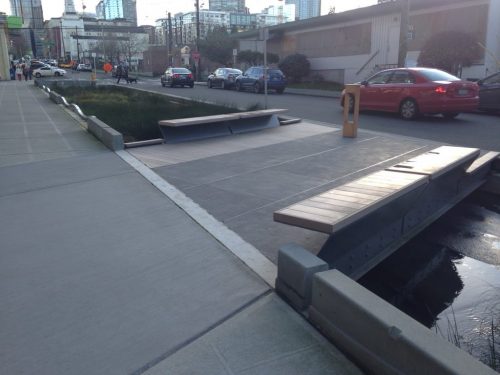Stormwater Collection
- Drainage Infrastructure
- Surface Drainage
- Stormwater Conveyance
- Public Storm Drains
- Ditch Modifications
- Maintenance Responsibilities
On this page:
Drainage Infrastructure
Drainage infrastructure shall be provided for improved streets and alleys and shall include catch basins and inlets that discharge to a public combined sewer, public storm drain, or other discharge point approved by SPU.
Surface Drainage
Standards for cross slopes and longitudinal slopes are important for vehicular and pedestrian safety as well as surface water conveyance. Cross slope of street shall ensure surface drainage flows to the gutter or flow line and is conveyed to drainage pickup points. Streets shall generally have a centerline crown elevation, with some exceptions, such as super-elevated streets. For alternative street grading concepts, designers have looked to the WSDOT Hydraulics manual for guidance on evaluating flow spread along the gutter line.
Links to Standard Plans and CAM
Standard Plans 200 Series: Sewer / Drainage Appurtenance,
Standard Specifications Division 7: Storm Drain, Sanitary and Combined Sewers, Water Mains and Related Structures
SPU CAM 1180: Design Guidelines for Public Storm Drain Facilities.
Stormwater Conveyance
Stormwater conveyance must be considered and included in all ROW project designs.

Conveyance Swales:
Stormwater is conveyed along a gutter line or along road side conveyance swales. Instead of using conveyance swales, a biofiltration swale may be proposed. A biofiltration swale is an open, gently sloped, vegetated channel designed to treat stormwater. Pollutant removal occurs by filtration as stormwater moves through the grass blades, which enhances sedimentation, and trapping and adhesion of pollutants to the grass and thatch. Biofiltration swales are designed so that stormwater will flow evenly across the entire width of a densely vegetated channel. A swale can be designed for both treatment and conveyance of stormwater flow. This combined use can reduce development costs by eliminating the need for separate conveyance and treatment systems. Biofiltration swales are typically configured as flow-through systems, with little or no detention or storage. Design information is provided in Section 5.8.3 of Stormwater Manual: Volume 3 – Project Stormwater Control and Standard Plan 294, in the Amendments section.
Public Storm Drains
A new public storm drain may be required:
- When there is no available public storm drain or public combined sewer, and there is no acceptable discharge point, and/or
- to achieve adequate capacity.
New public storm drains shall be sized to handle all upstream tributary area from the drainage basin in which they are located. They shall be designed to be continuous with existing and future storm drain pipes that are, or will be part of the storm drainage system. The engineer shall provide the hydraulic calculations used in the pipe design for review by SPU. Additional information is included in SPU CAM 1180 Design Guidelines for Public Storm Drain Facilities (2012).
Ditch Modifications
The City does not permit the replacement of an existing ditch with a culvert where the ditch functions as part of the City’s informal drainage system in the street right of way. After consultation with SPU, the SDOT Director may approve a requested exception per the Street Use Code SMC 15.04.112 (Decisions–review or reconsideration) if the Director determines that the modification is likely to be equally protective of public health, safety and welfare, the environment, or public and private property. If the proposed modification is not equally protective, the Director may approve a requested exception if substantial reasons are documented such as:
- An emergency situation necessitates approval of the exception;
- A reasonable use of the adjacent property is not possible unless the exception is approved; or harm or threat of harm to public health, safety and welfare, the environment, or public and private property is at risk unless the exception is approved.
Exceptions to the ditch filling moratorium policy include culvert installations that are necessary to implement driveway permits, and required street improvements. If you are considering modifying the ditches within a creek watershed, the City encourages use of a natural drainage system approach. The capacity calculations will be required to show that the proposed system can, at a minimum, provide the level of service of the existing conditions.
Maintenance Responsibilities
As with other types of street improvements, adjacent property owners are responsible for maintaining sidewalks, driveways and parking pads as well as landscaping in the street right-of-way. However, the City also has a maintenance role in bioretention and permeable pavement that is installed in the right-of-way for Stormwater Code compliance. Facility maintenance requirements will be confirmed as part of the Street Improvement Permit Process.
